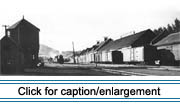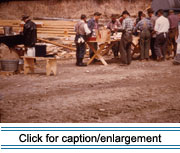|
 The
growth of the lumber industry provided opportunities for sons who could
work for a few years in the lumber camps and then buy a piece of land,
either from their father or another farmer. Young men could either work
as woodcutters, as log drivers, as suppliers to lumber mills, or could
combine lumbering with marginal agriculture in newly cleared areas (Craig
1991: 217). After a few years in the woods a young man could buy a farm
and get started in life. The
growth of the lumber industry provided opportunities for sons who could
work for a few years in the lumber camps and then buy a piece of land,
either from their father or another farmer. Young men could either work
as woodcutters, as log drivers, as suppliers to lumber mills, or could
combine lumbering with marginal agriculture in newly cleared areas (Craig
1991: 217). After a few years in the woods a young man could buy a farm
and get started in life.
The local population did not become wealthy through lumbering activities
because the industry was controlled by businessmen from outside the area
who did not integrate into local society. Being English-speaking Protestants,
they remained separate from the French-speaking Catholic majority. Not
all the entrepreneurs on the Maine side of the Valley were Americans;
some New Brunswickers became involved in the local lumber industry because
it was much easier for them to transport timber along the St. John River
down to sawmills in New Brunswick than it was for mill operators in Maine
to transport timber from the Upper St. John Valley to Bangor, Maine, and
elsewhere (Dubay 1983: 47).
 The
opening of the Bangor & Aroostook Railroad in 1899 finally gave residents
of the Maine portion of the Valley the opportunity to ship their lumber
directly to American markets. A second rail line was established in 1902
when the Fish River Railroad joined Fort Kent to the Bangor & Aroostook
Railroad (Dubay 1983: 49-51). The railroads also prompted the establishment
of starch mills to utilize culls and surpluses. Twentieth-century road
construction and commercial air links via Presque Isle further increased
communication between the Upper St. John Valley and the rest of the United
States. The
opening of the Bangor & Aroostook Railroad in 1899 finally gave residents
of the Maine portion of the Valley the opportunity to ship their lumber
directly to American markets. A second rail line was established in 1902
when the Fish River Railroad joined Fort Kent to the Bangor & Aroostook
Railroad (Dubay 1983: 49-51). The railroads also prompted the establishment
of starch mills to utilize culls and surpluses. Twentieth-century road
construction and commercial air links via Presque Isle further increased
communication between the Upper St. John Valley and the rest of the United
States.
 The
primary response of Acadian farmers to the development of the forest industry
was to supply food to lumber camps. But farming is a part-time occupation
in this northern climate and, because winter was the most favorable season
for working in the woods, a seasonal pattern of farming and forestry developed.
After crops were put away during the fall, many men moved to les chantiers
(lumber camps), where they worked until it was time to prepare for planting.
This seasonal pattern continued well into the 20th century. Mark Jalbert
of Frenchville remembers that his grandfather, Sam Jalbert, a famous wilderness
guide of the Allagash Wilderness Waterway, often worked as a foreman on
log drives. During the spring freshet, Sam Jalbert's crew floated logs
from the Allagash area down the St. John River to the mill in Keegan.
Mark remembers seeing pulpwood drives as a young boy during the early
1960s. The
primary response of Acadian farmers to the development of the forest industry
was to supply food to lumber camps. But farming is a part-time occupation
in this northern climate and, because winter was the most favorable season
for working in the woods, a seasonal pattern of farming and forestry developed.
After crops were put away during the fall, many men moved to les chantiers
(lumber camps), where they worked until it was time to prepare for planting.
This seasonal pattern continued well into the 20th century. Mark Jalbert
of Frenchville remembers that his grandfather, Sam Jalbert, a famous wilderness
guide of the Allagash Wilderness Waterway, often worked as a foreman on
log drives. During the spring freshet, Sam Jalbert's crew floated logs
from the Allagash area down the St. John River to the mill in Keegan.
Mark remembers seeing pulpwood drives as a young boy during the early
1960s.
|

